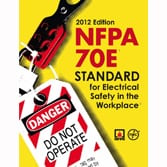NFPA 70E®: Standard for Electrical Safety in the Workplace® 2012
$166.99
The 2012 NFPA 70E®: Standard for Electrical Safety in the Workplace® is the solution to jobsite protection from electrical hazards.
Shock, electrocution, arc flash, and arc blast are responsible for one fatality every workday in the U.S., and some 8,00
In stock
Product Details
The 2012 NFPA 70E®: Standard for Electrical Safety in the Workplace® is the solution to jobsite protection from electrical hazards.
Shock, electrocution, arc flash, and arc blast are responsible for one fatality every workday in the U.S., and some 8,000 workers are treated in emergency rooms for electrical contact injuries each year. Now NFPA 70E–the Standard developed for OSHA–is revised to address safety gaps and increase electrical worker protection, while helping companies comply with OSHA 1910 Subpart S and OSHA 1926 Subpart K. Major changes recognize new hazards and address safety gaps.
Personal Protective Equipment (PPE) protects personnel and can significantly reduce the risk of injury in an arc flash. To help electrical engineers calculate incident energy–the vital first step in determining the correct type of PPE for a given task–revised Annex D consolidates all equations, adds new tables, and offers more options to detailed calculations.
Improved work practices reduce risks.
- To further reduce the risks for second-degree thermal burns, cotton outerwear is no longer permitted for energy levels below 2 cal/cm2.
- An expanded Table in Article 130 covers added tasks such as thermographic imaging, and new equipment including arc-resistant switchgear.
- Added Article 350 provides first-time requirements for the protection of electrical personnel in R&D labs.
- A new exception verifies that 240 V and less power systems fed by a single transformer less than 125 kvs no longer require an arc flash hazard analysis.
- Expanded requirements for multi-employer relationships address potential areas of oversight.
- New recordkeeping requirements for training and safety program audits answer OSHA’s need for records.
Annexes expand knowledge about electrical safety.
- Understand the Hazard/Risk evaluation procedure with clarification and sample worksheets in Annex F.
- Evaluate layering of PPE with new Annex M–Layering of Protective Clothing and Total System Arc Rating
- Develop and review plans for compliance using new Annex O–Safety-related Design Requirements.
- Follow safe work practices with new Annex N–Example Industrial Procedures and Policies for Working Near Overhead Electrical Lines
Contractors; risk managers; engineers; apartment, commercial, and retail building managers; and owners all have a stake in ending electrical-related accidents, liability, and loss. Rely on the 2009 NFPA 70E to improve worker safety and avoid citations, rising insurance fees, and increased workman’s comp costs. (Softbound, 98 pp., 2009)
About the Author:
NFPA is the leading information and knowledge resource on fire, electrical, and related hazards.



